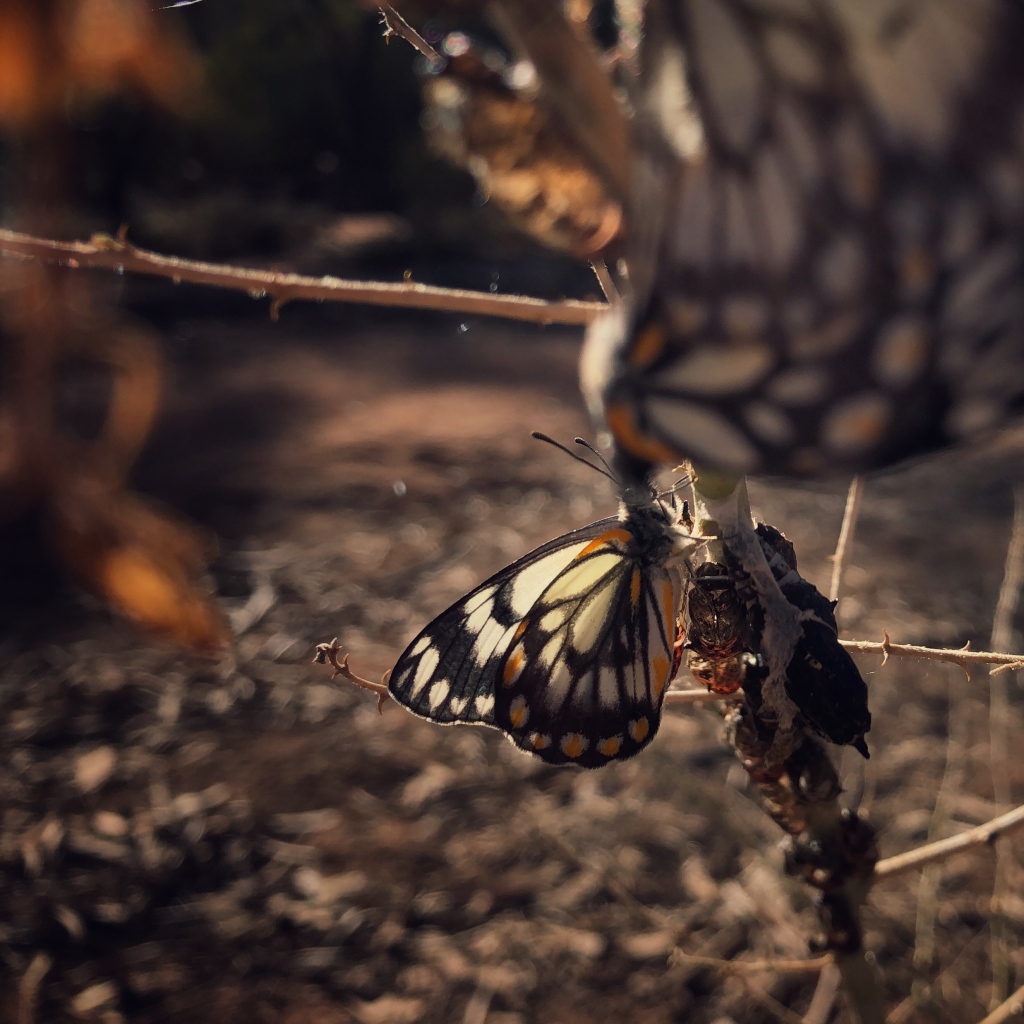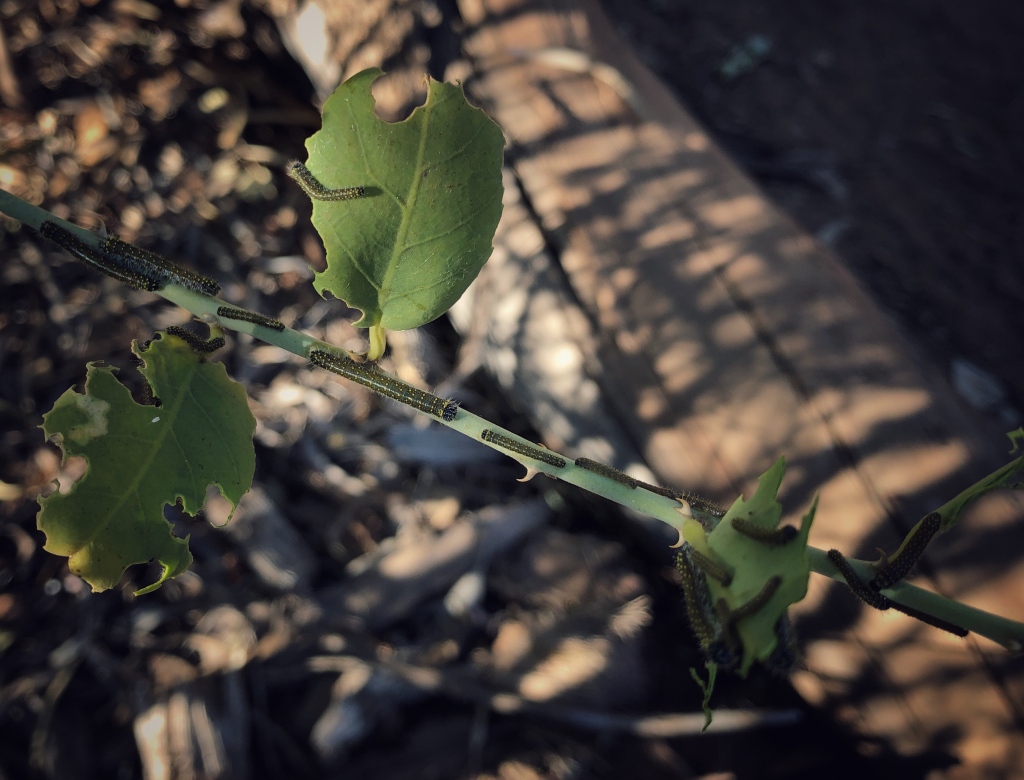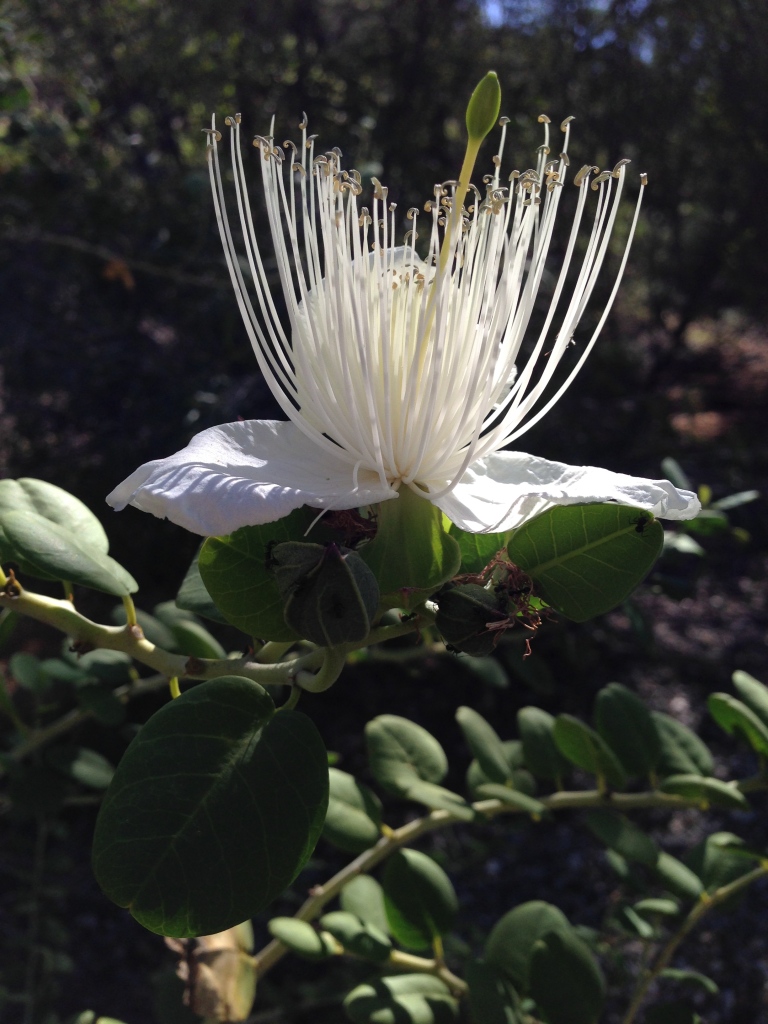Months can go by and nothing extra special happens on my walks. The walks are always special to me because I love the light and tiny changes I observe along the way…neighbours having lawn sales, trees shedding their bark or leafing in the spring, flowers defying the incredibly inhospitable conditions. In fact I was attempting to photograph a spring flower on a very dusty plant when something caught my attention. I think it was the bright white amongst all the red dust covered foliage because there certainly wasn’t much movement.

There just a few feet away was a white butterfly solidly clinging to a naked branch on a naked bush riddled with sharp thorns! I decided to see if the butterfly would sit still long enough for me to get a decent shot. Turned out, this Caper White butterfly wasn’t going anywhere. As I got closer I realised there were about 9 or 10 chrysalises lined up on the same branch, and it looked as if this was the first fully fledged butterfly to emerge. The transition from caterpillar to butterfly is really one of nature’s most amazing life cycles.
There were a few Capers flying in the area and I stopped to watch, but the solitary one on the branch held tight. I realised it would have been freshly emerged and trying to dry its wings so it could join the others.


The following morning I decided to again try my luck and chase the butterfly trail. Since there was not a single leaf left on the two bushes where I found chrysalises, I hadn’t been able to identify the plant they chose for their nursery. Fortunately, a local woman saw my Instagram post and added the identifying species of both plant and butterfly. Gold. When she said the name of the plant something seemed very familiar. I turned it over and over in my head and then looked it up online. More gold. It turned out, even though these bushes were currently without foliage, I had actually photographed one four years ago in full foliage and with a gorgeous blossom. Eureka! The plant is called Bush Passionfruit and both the blossom and the fruit hold some similarities to the domestic passionfruit. The blossom smells very sweet, has long stamen and the fruit is much smaller but sweet and usually attacked by birds and ants before humans can retrieve it! It is a well known bush food for the indigenous people. Apparently the plant recovers very quickly after the decimation of the leaves.




I still remember its heady perfume
On that last morning it seemed I had already enjoyed the peak activity on the previous day…until I walked away and saw another, larger nearly naked bush, with caterpillars and chrysalises on it. This completed the life cycle story. Oh, except for this shot…. someone is already doing some family planning for the future!

(this post was inspired by Kim Smith whose blog is called Nature is My Therapy. She writes compelling stories about her adventures and excellent photos to accompany the words)

When ere I see a butterfly as it flits and flutters by I stop and watch it dip and dive …it makes me glad that I’m alive! MeL 9/3/19 Sent from my iPhone Scroll down for Ardys photos and text. >
LikeLike
Yes, Mel, butterflies do indeed make one feel alive.
LikeLike
Simply beautiful!
Sent from Yahoo Mail on Android
LikeLike
Thank you Maralah!
LikeLike
Wonderful recounting of your exploration and investigation, Ardys! Those Capers are lovely.
LikeLike
Thank you Kim, and thanks for the inspiration!
LikeLike
Great to witness this cycle, not always easy finding newly emerged butterflies in the wild.
LikeLike
Thank you. I have never seen anything like it in the wild and it felt very special.
LikeLiked by 1 person
What you describe of your walks are the same things I am drawn to as I wander the woodlands. You truly did see everything come full circle with the capers. It doesn’t get any better than that!
LikeLike
I agree, Lori. It was very satisfying to see the whole thing.
LikeLiked by 1 person
Nature and art meet when you take a walk. In particular, the photo “White flashes amongst the dusty leaves” so simple, yet satisfies a hunger to behold beauty. To witness the full circle is equally satisfying, that the Caper White butterflies (good that they were identified, I was wondering from your Insta post what kind they were, and I remember the wild passionfruit pic… our local variety also are lovely to smell and eat) have emerged successfully to mate again gives me hope. Nice one 🙂
LikeLiked by 1 person
Thank you so much Dale. I’m a bit tardy in replying…a temporary adjustment period to my husband’s new schedule has me at sixes and sevens. I checked the nursery again today and there are more chrysalises yet to develop but I doubt I will be lucky enough to see them at their peak as with this one. A very fun experience.
LikeLiked by 1 person
You’ve found some beautiful nature moments, Ardys. Love that Bush Passionfruit flower.
LikeLike
Thank you so much, Jane. Yes, that Bush Passionfruit flower is special.
LikeLiked by 1 person